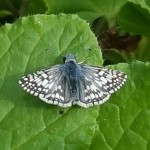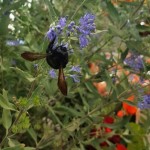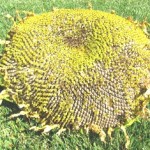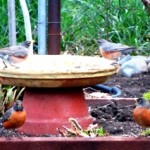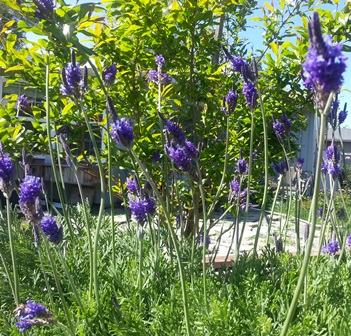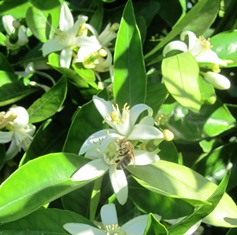Plant for the Pollinators
I seldom need an occasion to put in another bed of flowers, but this is National Pollinator Week. I think a new bed is in order to attract local bees, birds, bats, and butterflies–all considered pollinators. Having these small creatures around benefits landscapes, gardens, and orchards.
The U.S. Fish and Wildlife Service has noted that over 75 percent of our plants are pollinated by birds, animals, and insects. We can help ensure these creatures will be around for a long time if we restore their habitats and ensure they have food and water.
There are many lovely plants you can grow that don’t require a lot of care.
- lavender
- bee balm
- echinacea
- sage
- cilantro
- thyme
- sunflowers
- sweet alyssum
- anemone
- borage
- geraniums
- scented pelargoniums
- mint
A tapestry of colorful herbs and flowers beautifies your landscape and pollinators love the diversity. If you don’t have a lot of space, grow some of these plants in planter boxes, clay pots, or other types of containers.
Put in a water feature, too, such as a table-top or larger fountain that recycles water. Even a pottery saucer filled each day can attract pollinators.
It won’t take long for the bees and hummingbirds to find the water. Their frequent visits are fun to watch, and they’ll likely be sipping throughout the day.
_________________________________________________________________________
If you enjoy reading about farmette topics, check out my Henny Penny Farmette series of cozy mysteries from Kensington Publishing. My newest novel includes delicious recipes, tips on keeping bees and chickens, and much more. Click on this URL for more information, http://tinyurl.com/ya5vhhpm
.
Fern-leaf Lavender Is Easy to Grow and Re-seeds
My hubby brought home several Lavandula multifida plants in five-gallon pots. Also known as Egyptian lavender or Fern-leaf lavender, the plant’s foliage appears fernlike, hence its common name.
The Fern-leaf lavender carries its bluish-purple bloom on three- to five-inch spikes. It’s a pretty plant in the garden, however, its scent is not of lavender as one might expect but rather more like oregano. The foliage is more pungently scented than the buds.
This evergreen perennial is classified as a sub-shrub. In cold climates, the frost kills it. However, it can be grown as an annual. In California and Arizona, the plant blooms from spring through late summer into fall. The blooms are tri-pronged.
These plants reach a height of about 24 inches. They are among the 39 species of lavender that belong to the genus Lavandula in the family of Labiatae (a family which also includes mint, rosemary, thyme, sage, savory, and basil).
The Fern-leaf lavender (like other species of Lavandula) attracts bees, butterflies, and other pollinators. It’s a lovely plant that will provide spectacular color in any garden or around a pool.
For more gardening tips, delicious recipes, farm sayings, and a fun mystery, check out my Henny Penny Farmette series of cozy mysteries, including A BEELINE TO MURDER, and THE MURDER OF A QUEEN BEE.
My books are available on Amazon, Barnesandnoble.com, and other online and traditional bookstores. See, http://www.amazon.com/Beeline-Murder-Henny-Farmette-Mystery/dp/161773909X/ref=sr_1_3?s=books&ie=UTF8&qid=1458077651&sr=1-3&keywords=Meera+Lester
Heirloom Herbs for the Kitchen
The green stalks of the red and yellow onions I planted in late summer are now up about a foot in a raised bed. The garlic that I planted around the same time is also poking up. Having onions, garlic, and fresh culinary herbs available year-round is not impossible in the Bay Area’s mild climate, especially when they are grown in cold frames, protected areas, and raised beds.
Some will re-seed themselves in the growing beds or around your yards. We’ve got Greek oregano and chives growing all over the place. Some of my favorites herbs include basil, cilantro, chervil, chives, dill, fennel, lemon balm, lavender, oregano, mint, marjoram, rosemary, thyme, parsley, sage, and savory.
We also grow a few ornamental herbs such as borage, hyssop, and catnip (for our new kitty), tea herbs (chamomile and mint), and medicinal herbs (like echinacea).
Herbs are easy to grow. Their blooms will attract insects beneficial to the garden. Butterflies and hummingbirds are also attracted. And herbs don’t need much–light, and porous soil, warmth, and decent drainage. For a light feeding of the herbs, we make chicken poop tea. With so many varieties of herbs available, why not tuck a few in your garden or in containers in a protected but sunny and warm area of your patio to enjoy in your culinary creations?
Edible Flowers Add Flavor and A Flourish
Picture a red nasturtium or peppery-tasting marigold displayed around a mound of lemony-yellow butter. Or, imagine the beauty of a handful of sugared purple violets or red rose petals, sans the sour petal base, crowning an iced picnic cake.
During bygone eras when the Romans ruled the world or Queen Victoria reigned during the age named for her, flowers weren’t just for bouquets on the table, they formed an integral part of the food that was consumed.
Many flowers and seeds are poisonous, so it is imperative that you correctly identify any flower or plant you plan to eat or use on food. Also, make sure you are not allergic to the plant before integrating its blooms into your diet.
Several edible florals include the blossoms of herbs such as lavender, dill, garlic chive, coriander, basil, bee balm, marjoram, oregano, anise hyssop, winter savory, summer savory, sage, and mint. Also edible are the flowers of certain varieties of pumpkins, squash, cauliflower, scarlet runner bean, radish, sweet garden pea, and fennel.
Consider also the delicate blooms of society garlic, dianthus, pansy, signet marigold, red clover, African marigold, plum, scented geranium (rose, lemon). You can candy the blossoms of apple and crabapple, but the seeds are poisonous.
Some blooms, such as hibiscus (China rose), mint, rose, and chamomile are used to flavor teas. Lemon blossoms will have a slightly bitter taste whereas orange blossoms are sweet but both are lovely floating in crystal bowls of punch.
Research your chosen plant and correctly identify it before using it in any food preparation. See, http://www.extension.iastate.edu/publications/rg302.pdf
Also see, http://www.ext.colostate.edu/pubs/garden/07237.html
Herbs for Healing and Well-Being
For thousands of years, humankind has relied on the healing properties of herbs, plucked in the wild or cultivated in gardens, to treat what has ailed them. Modern holistic practitioners value herbs and plant-based medicines as integral elements in re-balancing the health of their patients and fostering wellness and robust vitality.
Doctors trained in allopathic or mainstream Western medicine traditionally have prescribed chemically based medicines (that usually have side effects). However, Western-trained doctors may also recommend the use of herbs for certain health issues. Always talk with your physician before starting any type of self-treatment with herbs. Keep your physician informed of herbs you may be taking. Herbs or herb formulations can interact or even block the efficacious effect of the medications your doctor has prescribed.
Dr. Andrew Weil, the Harvard-trained physician who pioneered the field of integrative medicine (combining mainstream and alternative medicine) and also wrote several best-selling books, suggests three specific herbs can reduce inflammation in the body–tumeric, ginger, and boswellia. These herbs can be found in specific doses formulated in capsules to make it easy to take the right amount. See, http://www.drweil.com/drw/u/QAA142972/Anti-Inflammatory-Herbs.com.
In traditional Chinese medicine, four herbs play vital roles in achieving a state of well-being. Rosemary stimulates brain alertness, mint aids in digestion, sage supports mental acuity, and parsley protects the eyes. See, http://www.doctoroz.com/blog/mao-shing-ni-lac-dom-phd/4-commonly-used-healing-herbs.
Whether herbs are used dried or fresh, made into a tea, tincture, culinary preparation, or packaged in capsules and other forms, they are often included as part of a larger health-focused program to restore and maintain a balanced, healthy body.
Ayurveda, a healing system used in India since ancient times, utilizes herbs in treatments that can encompass many healing modalities. According to Ayurveda, a balanced, healthy body depends on a strong metabolic and immune system, attained through proper nutrition, exercise, yoga, and meditation (to relieve tension and stress that can accumulate in the body and mind).
Herbs used in Ayurveda are many and include (but are not limited to) andrographis, ashwagandha, black mustard seed, cardamom, coriander, cumin, ginger, purslane (pigweed), tulsi (holy basil), tumeric, and visnaga.
During the medieval period, gardens of priests, convents, and cloisters contained the herbs that members of the clergy as well as ordinary people believed could treat or cure them of their ailments. In the twelfth century, German mystic Saint Hildegard of Bingen wrote about health and healing, detailing medicinal uses of over 200 healing plants.
Although most herbs are fairly easy to grow, take the time to learn about them. Provide for the plant’s needs (water, nutrients, sun or shade requirement). Find out when to harvest and how best to use the plant for your health and well-being. Find out what the negative factors might be in using a specific herb or medicinal plant. When you engage in this type of work, you continue a practice begun thousands of years ago that can have health benefits for you today. But don’t forget to have that discussion with your doctor before taking medicinal herbs.
 Facebook
Facebook Goodreads
Goodreads LinkedIn
LinkedIn Meera Lester
Meera Lester Twitter
Twitter




